An Extension of the Exit Choice Model: Considering the Variance in the Perspectives of Evacuees When Interacting with the Spread of Fire
Abstract
:1. Introduction
2. Literature Review
2.1. Evacuation Simulation Models and the Social Force Model
2.2. Exit Choice Models
2.3. Rule-Based Exit Choice Model and Problematic Issue
3. Methodology
3.1. Exit and Route Choice Methodology
3.2. Route Planning Methodology
3.3. Composing Extreme Route
3.4. Extreme Route’s Time Disutility
3.5. Stochastic Model for Agents’ Perspectives and Time Disutility
3.6. The Decision for the Representative Route
4. Simulation
4.1. The Suggested Stochastic Distribution
4.2. Simulation
5. Results and Discussion
- Entering agents are collectively walking towards the upper exit, although it is impractical.
- Agents clogging lower exits are leaving for alternatives (the upper exit and the lower right corner) to escape the threat of fire.
- The accumulated agents at the lower exit are exposed to fire. They are in blocked situations. Thus, pushing behaviors are dominant when escaping from the fire.
- The agents next to the lower wall retreat. Some agents become confined and threatened by fire.
- Most agents make decisions by escaping toward the stairs because of the impracticality of the upper exit.
- The lower exit is threatened by fire. However, a few agents accumulate and leave the lower exit to the upper exit.
- No agents were found to be burned by the fire. No blocked agent pushed each other.
- No agents were found retreating back towards the lower wall.
6. Conclusions
Funding
Institutional Review Board Statement
Informed Consent Statement
Data Availability Statement
Acknowledgments
Conflicts of Interest
Appendix A
References
- Wijermans, N.; Conrado, C.; van Steen, M.; Martella, C.; Li, J. A landscape of crowd-management support: An integrative approach. Saf. Sci. 2016, 86, 142–164. [Google Scholar] [CrossRef] [Green Version]
- Martella, C.; Li, J.; Conrado, C.; Vermeeren, A. On current crowd management practices and the need for increased situation awareness, prediction, and intervention. Saf. Sci. 2017, 91, 381–393. [Google Scholar] [CrossRef]
- Haghani, M. Optimising crowd evacuations: Mathematical, architectural and behavioural approaches. Saf. Sci. 2020, 128, 104745. [Google Scholar] [CrossRef]
- Balboa, A.; González-Villa, J.; Cuesta, A.; Abreu, O.; Alvear, D. Testing a real-time intelligent evacuation guiding system for complex buildings. Saf. Sci. 2020, 132, 104970. [Google Scholar] [CrossRef]
- Al-nasur, S.J.; Wadoo, S.A.; Shende, A.; Kachroo, P. Pedestrian Dynamics: Feedback Control of Crowd Evacuation; Springer Science & Business Media: Berlin/Heidelberg, Germany, 2008. [Google Scholar]
- Li, X.; Geng, Z.; Kuang, H.; Bai, X.; Fan, Y. Effect of dangerous source on evacuation dynamics in pedestrian counter flow. Phys. A Stat. Mech. Appl. 2019, 533, 122047. [Google Scholar] [CrossRef]
- Vreugdenhil, B.J.; Bellomo, N.; Townsend, P.S. Using crowd modelling in evacuation decision making. In Proceedings of the ISCRAM 2015 12th International Conference on Information Systems for Crisis Response and Management, Kristiansand, Norway, 24–27 May 2015. [Google Scholar]
- Song, Y.; Liu, J.; Liu, Q. Dynamic decision-making process of evacuees during post-earthquake evacuation near an automatic flap barrier gate system: A broken windows perspective. Sustainability 2021, 13, 8771. [Google Scholar] [CrossRef]
- Wang, H.; Xu, T.; Li, F. A novel emergency evacuation model of subway station passengers considering personality traits. Sustainability 2021, 13, 10463. [Google Scholar] [CrossRef]
- Kim, H.; Kim, J.; Rie, D. A study on the application of the safety practice index to reduce safety accidents in the manufacturing industry. Sustainability 2021, 13, 10990. [Google Scholar] [CrossRef]
- Shipman, A.; Majumdar, A. Fear in humans: A glimpse into the crowd-modeling perspective. Transp. Res. Rec. 2018, 2672, 183–197. [Google Scholar] [CrossRef] [Green Version]
- Haghani, M.; Sarvi, M.; Rajabifard, A. Simulating indoor evacuation of pedestrians: The sensitivity of predictions to directional-choice calibration parameters. Transp. Res. Rec. 2018, 2672, 171–182. [Google Scholar] [CrossRef] [Green Version]
- Berg, M.V.D.; van Nes, R.; Hoogendoorn, S. Estimating choice models to quantify the effect of herding on the decision to evacuate: Application of a serious gaming experimental setup. Transp. Res. Rec. 2018, 2672, 161–170. [Google Scholar] [CrossRef] [Green Version]
- Musharraf, M.; Smith, J.; Khan, F.; Veitch, B.; MacKinnon, S. Incorporating individual differences in human reliability analysis: An extension to the virtual experimental technique. Saf. Sci. 2018, 107, 216–223. [Google Scholar] [CrossRef]
- Wattanasaeng, N.; Ransikarbum, K. Model and analysis of economic- and risk-based objective optimization problem for plant location within industrial estates using epsilon-constraint algorithms. Computation 2021, 9, 46. [Google Scholar] [CrossRef]
- Chanthakhot, W.; Ransikarbum, K. Integrated IEW-TOPSIS and fire dynamics simulation for agent-based evacuation modeling in industrial safety. Safety 2021, 7, 47. [Google Scholar] [CrossRef]
- Kuligowski, E.D.; Peacock, R.D.; Hoskins, B.L. A Review of Building Evacuation Models, 2nd ed.; US Department of Commerce: Washington, DC, USA; National Institute of Standards and Technology: Gaithersburg, MD, USA, 2010.
- Haghani, M.; Sarvi, M. Stated and revealed exit choices of pedestrian crowd evacuees. Transp. Res. Part B Methodol. 2017, 95, 238–259. [Google Scholar] [CrossRef]
- Ransikarbum, K.; Kim, N.; Ha, S.; Wysk, R.A.; Rothrock, L. A highway-driving system design viewpoint using an agent-based modeling of an affordance-based finite state automata. IEEE Access 2017, 6, 2193–2205. [Google Scholar] [CrossRef]
- Sargent, R.G.; Balci, O. History of verification and validation of simulation models. In Proceedings of the 2017 Winter Simulation Conference (WSC), Las Vegas, NV, USA, 3–6 December 2017; pp. 292–307. [Google Scholar] [CrossRef]
- Dias, C.; Lovreglio, R. Calibrating cellular automaton models for pedestrians walking through corners. Phys. Lett. A 2018, 382, 1255–1261. [Google Scholar] [CrossRef]
- Huang, L.; Gong, J.; Li, W.; Xu, T.; Shen, S.; Liang, J.; Feng, Q.; Zhang, D.; Sun, J. Social force model-based group behavior simulation in virtual geographic environments. ISPRS Int. J. Geo-Inf. 2018, 7, 79. [Google Scholar] [CrossRef] [Green Version]
- Zhiming, F.; Xingpeng, X.; Lixue, J.; Xiaolian, L.; Nan, H. Study on the exit-selecting behavior in underground indoor space with fire using a virtual experiment. Tunn. Undergr. Space Technol. 2021, 112, 103936. [Google Scholar] [CrossRef]
- Peizhong, Y.; Xin, W.; Tao, L. RETRACTED: Agent-based simulation of fire emergency evacuation with fire and human interaction model. Saf. Sci. 2011, 49, 1130–1141. [Google Scholar] [CrossRef]
- Xie, Q.-M.; Wang, J.-H.; Wang, P.-C.; Wang, W.; Jiao, Y.; Guo, J. The optimization for location of building evacuation exits considering the uncertainty of occupant density using polynomial chaos expansion and genetic algorithm. Procedia Eng. 2018, 211, 818–829. [Google Scholar] [CrossRef]
- Huang, H.-J.; Guo, R.-Y. Static floor field and exit choice for pedestrian evacuation in rooms with internal obstacles and multiple exits. Phys. Rev. E 2008, 78, 021131. [Google Scholar] [CrossRef] [PubMed]
- Zheng, Y.; Jia, B.; Li, X.-G.; Zhu, N. Evacuation dynamics with fire spreading based on cellular automaton. Phys. A Stat. Mech. Appl. 2011, 390, 3147–3156. [Google Scholar] [CrossRef]
- Cao, S.; Song, W.; Lv, W.; Fang, Z. A multi-grid model for pedestrian evacuation in a room without visibility. Phys. A Stat. Mech. Appl. 2015, 436, 45–61. [Google Scholar] [CrossRef]
- Shuaib, M.M. Incorporating intelligence for typical evacuation under the threat of fire spreading. Saf. Sci. 2018, 106, 1–9. [Google Scholar] [CrossRef]
- Zheng, Y.; Jia, B.; Li, X.-G.; Jiang, R. Evacuation dynamics considering pedestrians’ movement behavior change with fire and smoke spreading. Saf. Sci. 2017, 92, 180–189. [Google Scholar] [CrossRef]
- Joo, J.; Kim, N.; Wysk, R.A.; Rothrock, L.; Son, Y.-J.; Oh, Y.-G.; Lee, S. Agent-based simulation of affordance-based human behaviors in emergency evacuation. Simul. Model. Pract. Theory 2013, 32, 99–115. [Google Scholar] [CrossRef]
- Shuaib, M.; Zainuddin, Z. Incorporating intelligence for overtaking moving threatening obstacles. Int. Arab. J. Inf. Technol. 2020, 17, 598–606. [Google Scholar] [CrossRef]
- Lee, M.; Lee, J.; Jun, C. An extended floor field model considering the spread of fire and detour behavior. Phys. A Stat. Mech. Appl. 2021, 577, 126069. [Google Scholar] [CrossRef]
- Hughes, R.L. A continuum theory for the flow of pedestrians. Transp. Res. Part B Methodol. 2002, 36, 507–535. [Google Scholar] [CrossRef]
- Helbing, D.; Molnár, P. Social force model for pedestrian dynamics. Phys. Rev. E 1995, 51, 4282–4286. [Google Scholar] [CrossRef] [Green Version]
- Blue, V.J.; Adler, J.L. Cellular automata microsimulation for modeling bi-directional pedestrian walkways. Transp. Res. Part B Methodol. 2001, 35, 293–312. [Google Scholar] [CrossRef]
- Burstedde, C.; Klauck, K.; Schadschneider, A.; Zittartz, J. Simulation of pedestrian dynamics using a two-dimensional cellular automaton. Phys. A Stat. Mech. Appl. 2001, 295, 507–525. [Google Scholar] [CrossRef] [Green Version]
- Muramatsu, M.; Irie, T.; Nagatani, T. Jamming transition in pedestrian counter flow. Phys. A Stat. Mech. Appl. 1999, 267, 487–498. [Google Scholar] [CrossRef]
- Guo, X.; Chen, J.; You, S.; Wei, J. Modeling of pedestrian evacuation under fire emergency based on an extended heterogeneous lattice gas model. Phys. A Stat. Mech. Appl. 2013, 392, 1994–2006. [Google Scholar] [CrossRef]
- Zhang, L.; Wang, J.; Shi, Q. Multi-agent based modeling and simulating for evacuation process in stadium. J. Syst. Sci. Complex. 2014, 27, 430–444. [Google Scholar] [CrossRef]
- Helbing, D.; Farkas, I.; Molnar, P. Simulation of pedestrian crowds in normal and evacuation situations. Pedestr. Evacuation Dyn. 2002, 21, 21–58. [Google Scholar]
- Lakoba, T.I.; Kaup, D.J.; Finkelstein, N.M. Modifications of the Helbing-Molnár-Farkas-Vicsek social force model for pedestrian evolution. Simulation 2005, 81, 339–352. [Google Scholar] [CrossRef]
- Siddharth, S.M.P.; Vedagiri, P. Modeling the gender effects of pedestrians and calibration of the modified social force model. Transp. Res. Rec. 2018, 2672, 1–9. [Google Scholar] [CrossRef]
- Johansson, A. Constant-net-time headway as a key mechanism behind pedestrian flow dynamics. Phys. Rev. E 2009, 80, 026120. [Google Scholar] [CrossRef] [PubMed] [Green Version]
- Alia, O.M.; Shuaib, M.M. A harmony search algorithm for the reproduction of experimental data in the social force model. J. Appl. Math. 2014, 2014, 954607. [Google Scholar] [CrossRef]
- Shuaib, M.M.; Alia, O.M.; Zainuddin, Z. Incorporating prediction factor into the investigation capability in the social force model: Application on avoiding grouped pedestrians. Appl. Math. Inf. Sci. 2013, 7, 323–331. [Google Scholar] [CrossRef]
- Shuaib, M.M. Modeling the capability of penetrating a jammed crowd to eliminate freezing transition. Chin. Phys. B 2016, 25, 050501. [Google Scholar] [CrossRef]
- Shuaib, M.M. Preserving socially expected crowd density in front of an exit for the reproduction of experimental data by modeling pedestrians’ rear perception. J. Stat. Mech. Theory Exp. 2014, 2014, P10037. [Google Scholar] [CrossRef]
- Guo, N.; Jiang, R.; Hu, M.-B.; Ding, J.-X. Constant evacuation time gap: Experimental study and modeling. Chin. Phys. B 2017, 26, 120506. [Google Scholar] [CrossRef]
- Helbing, D.; Farkas, I.; Vicsek, T. Simulating dynamical features of escape panic. Nature 2000, 407, 487–490. [Google Scholar] [CrossRef] [Green Version]
- Zhang, G.; Huang, D.; Zhu, G.; Yuan, G. Probabilistic model for safe evacuation under the effect of uncertain factors in fire. Saf. Sci. 2017, 93, 222–229. [Google Scholar] [CrossRef]
- Duives, D.C.; Daamen, W.; Hoogendoorn, S. State-of-the-art crowd motion simulation models. Transp. Res. Part C Emerg. Technol. 2013, 37, 193–209. [Google Scholar] [CrossRef]
- Ehtamo, H.; Heliövaara, S.; Hostikka, S.; Korhonen, T. Modeling evacuees’ exit selection with best response dynamics. In Proceedings of the 4th International Conference on Pedestrian and Evacuation Dynamics, Wuppertal, Germany, 27–29 February 2008. [Google Scholar]
- Braglia, M.; Castellano, D.; Gabbrielli, R. A novel game theory based exit selection model in emergency conditions. Adv. Complex Syst. 2013, 16, 1350018. [Google Scholar] [CrossRef]
- Duives, D.C.; Mahmassani, H.S. Exit choice decisions during pedestrian evacuations of buildings. Transp. Res. Rec. 2012, 2316, 84–94. [Google Scholar] [CrossRef]
- Lovreglio, R.; Fonzone, A.; dell’Olio, L.; Borri, D. A study of herding behaviour in exit choice during emergencies based on random utility theory. Saf. Sci. 2016, 82, 421–431. [Google Scholar] [CrossRef] [Green Version]
- Liao, W.; Wagoum, A.U.K.; Bode, N.W.F. Route choice in pedestrians: Determinants for initial choices and revising decisions. J. R. Soc. Interface 2017, 14, 20160684. [Google Scholar] [CrossRef] [PubMed]
- Wang, J.; Zhang, L.; Shi, Q.; Yang, P.; Hu, X. Modeling and simulating for congestion pedestrian evacuation with panic. Phys. A Stat. Mech. Appl. 2015, 428, 396–409. [Google Scholar] [CrossRef]
- Jiang, Y.; Chen, B.; Li, X.; Ding, Z. Dynamic navigation field in the social force model for pedestrian evacuation. Appl. Math. Model. 2020, 80, 815–826. [Google Scholar] [CrossRef]
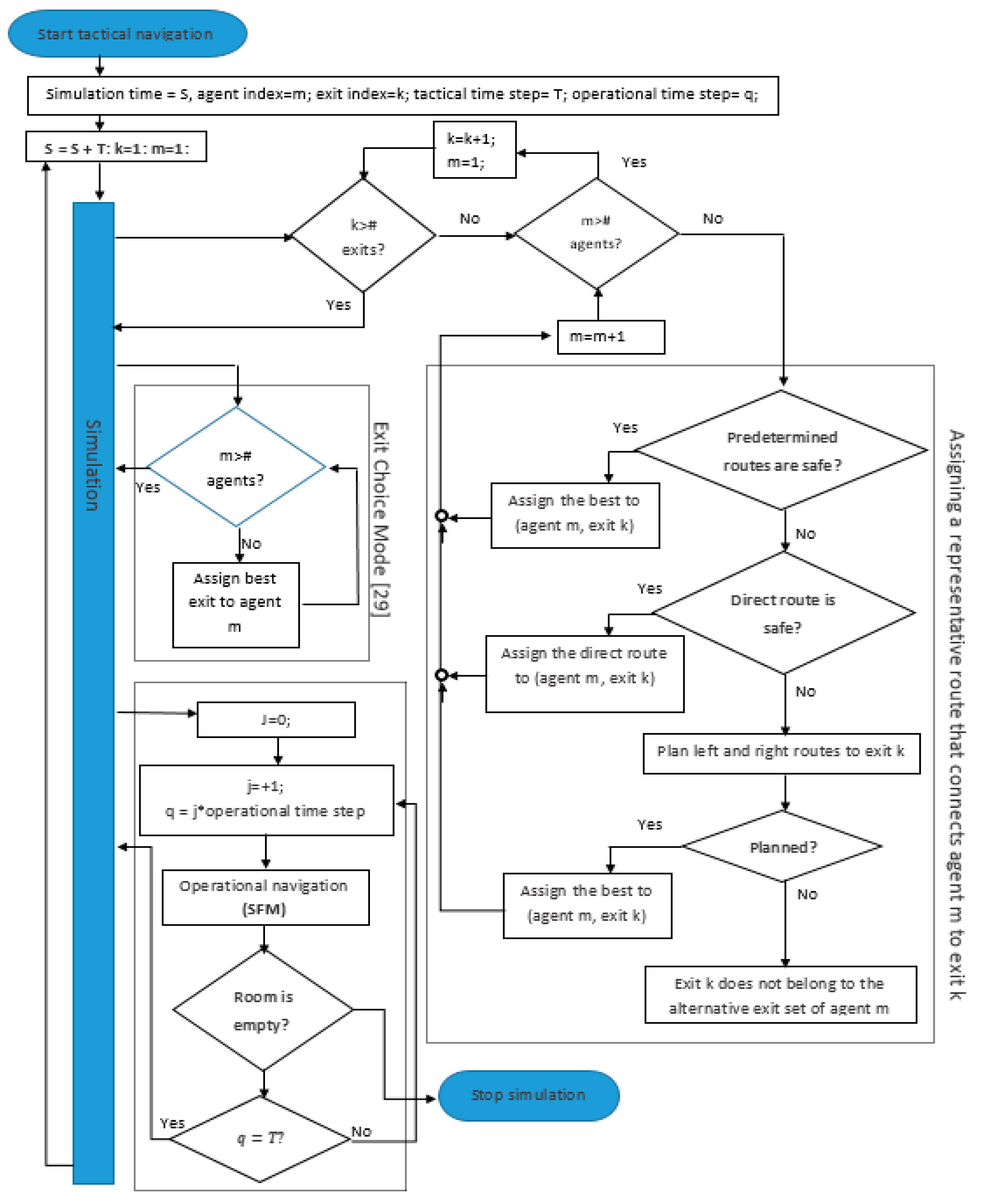
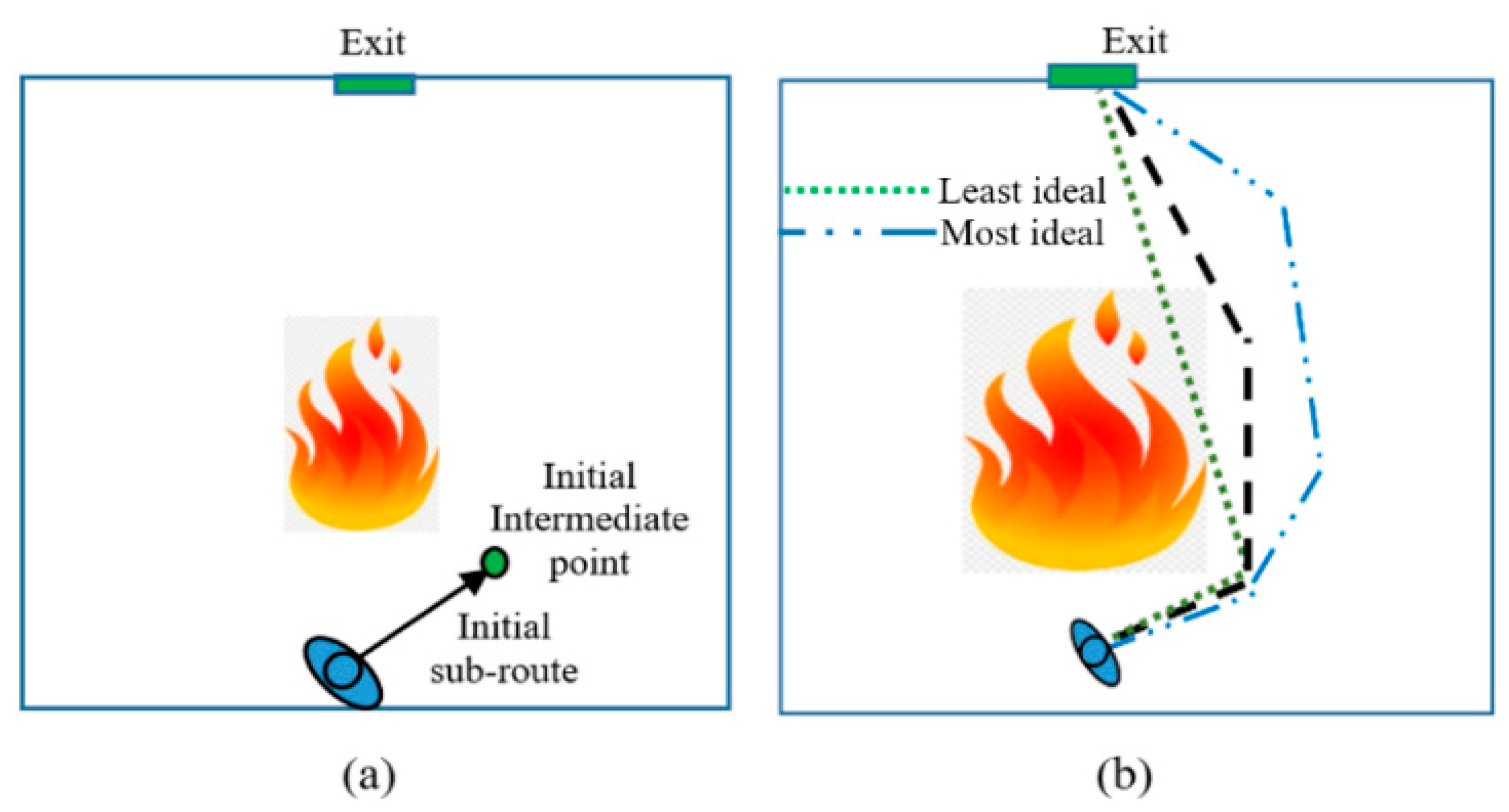
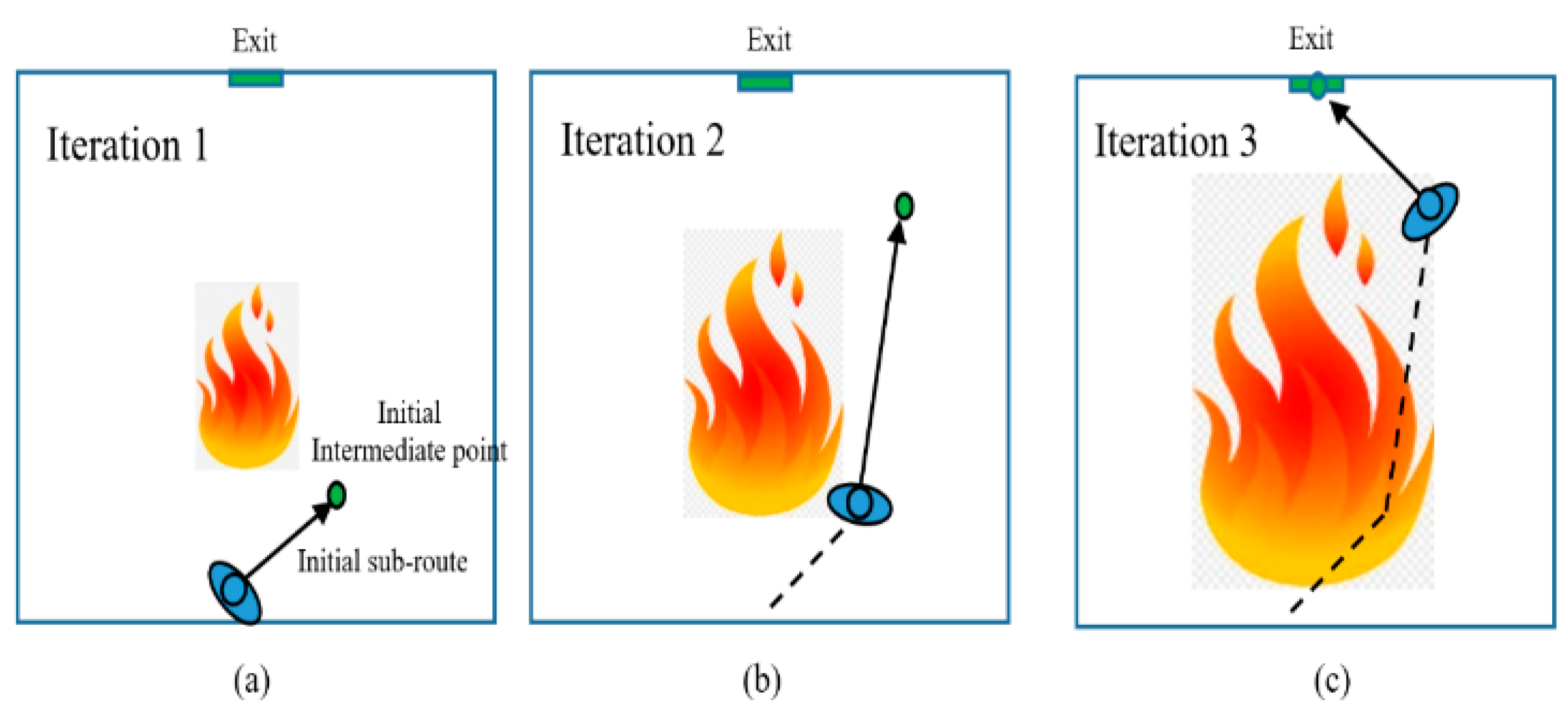
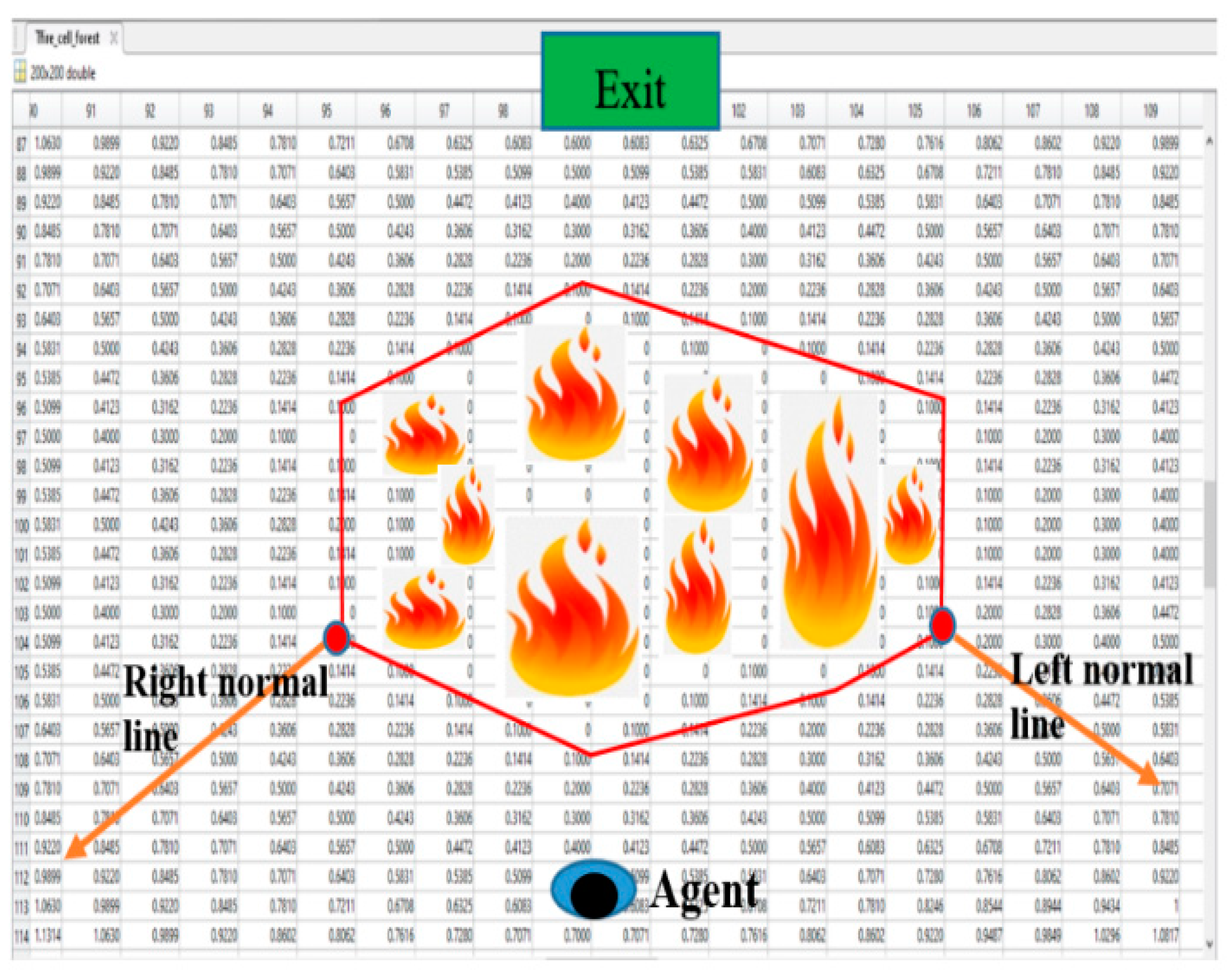
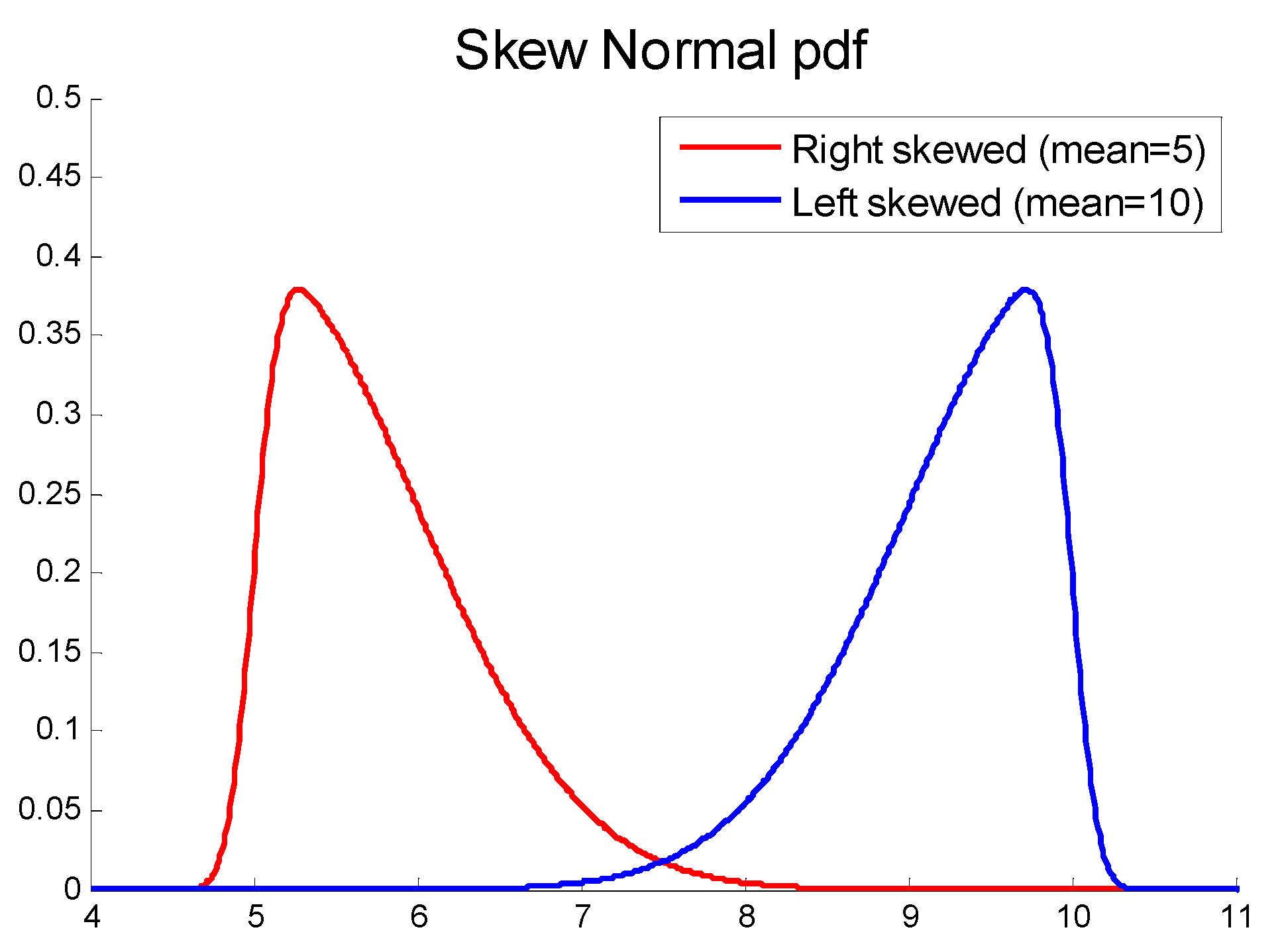
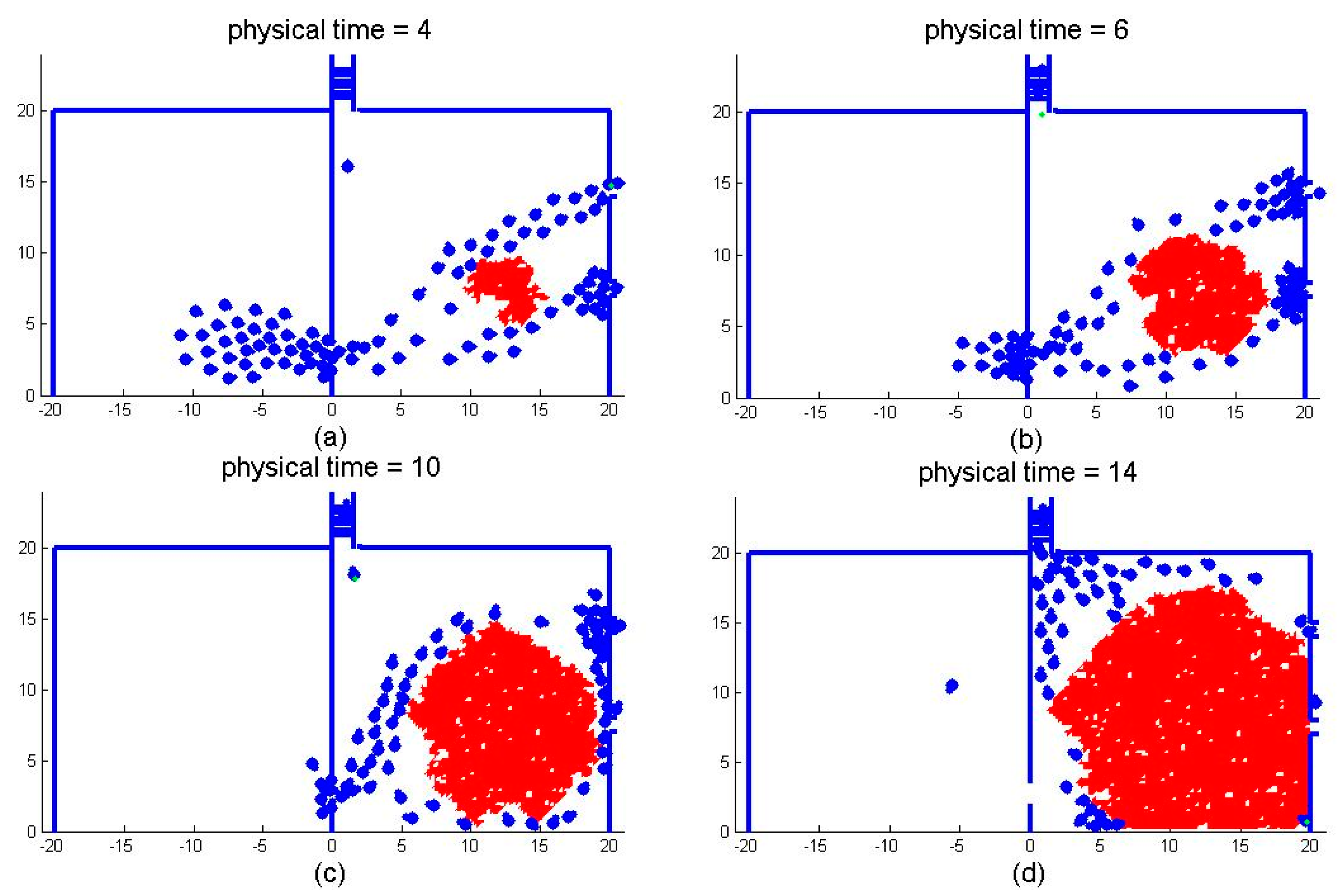
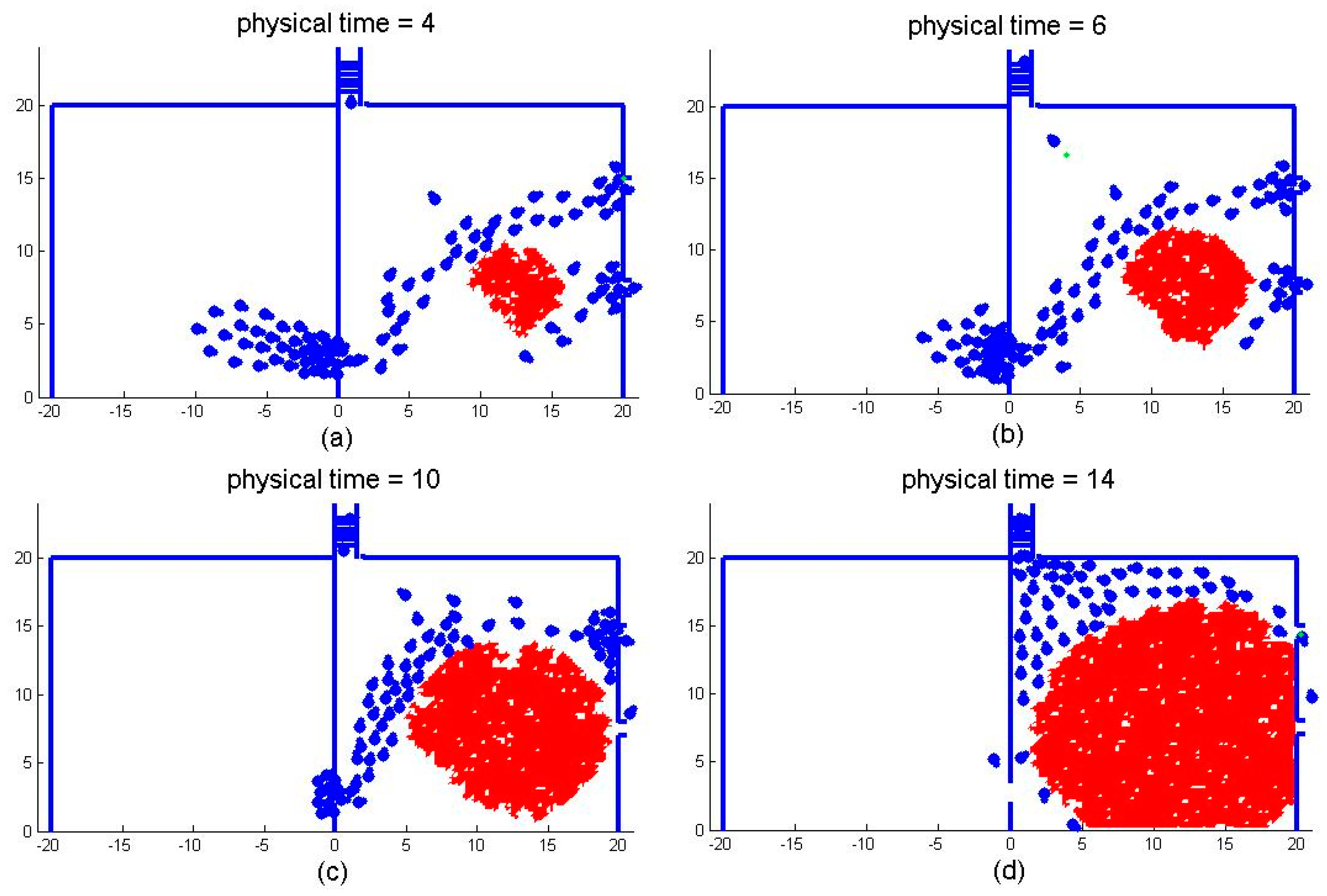
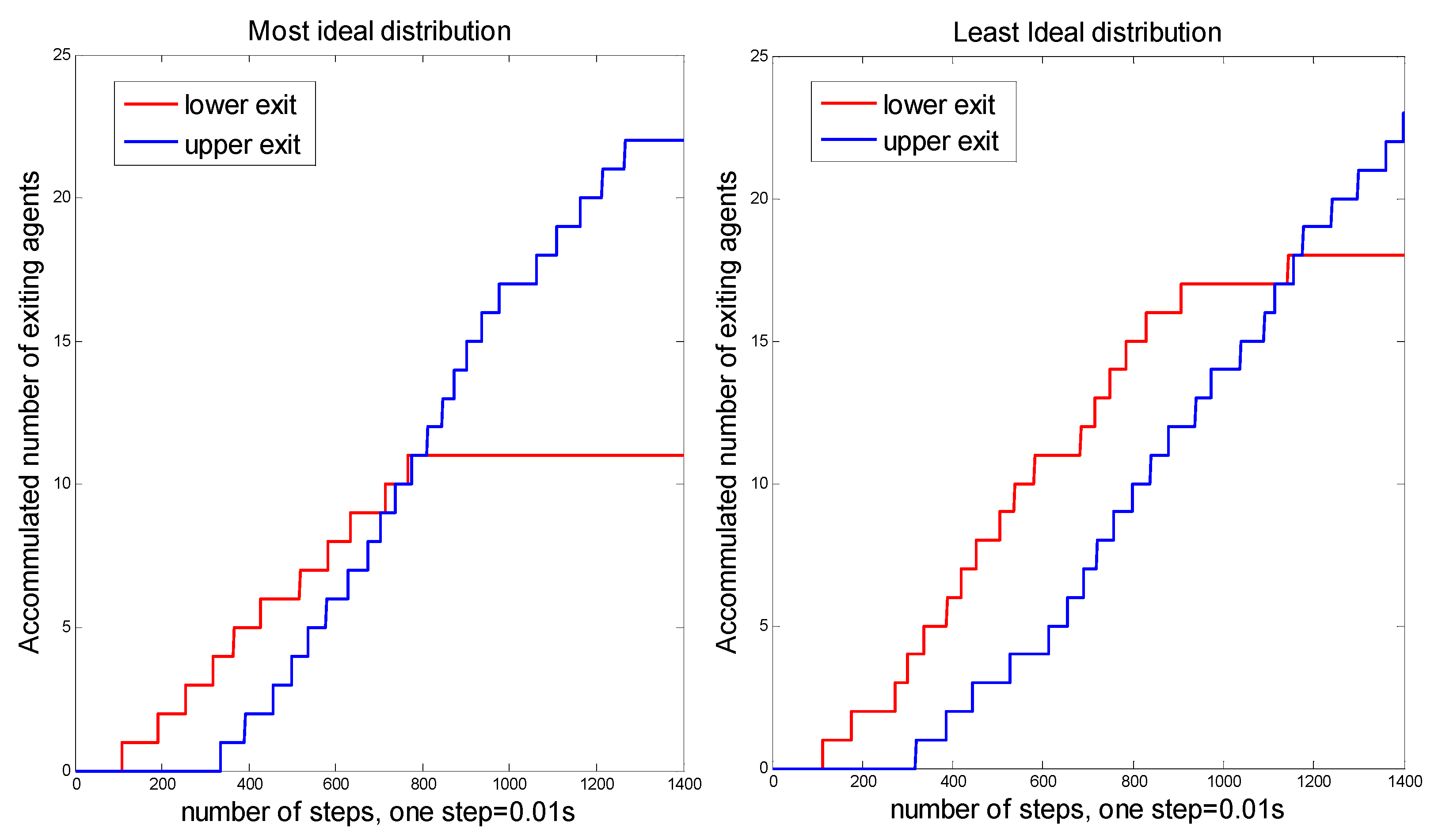
| The Agents’ Parameters: | |
|---|---|
| The agents’ mass: uniformly distributed within the range [77, 83] kg | |
| The preferred speed in an emergency situation | |
| The reaction time | |
| The parameters of the proposed model: | |
| The exit threshold is the minimum time utility which serves to change the exit. | |
| The route threshold is the minimum time utility which serves to change the route. | |
| The time step of the detection and making decision processes for optimal exit. | |
| The time step of the detection and making decision processes for optimal route. | |
| Left-Skewed | Symmetric | Right Skewed | ||
|---|---|---|---|---|
| evacuated agents | Lower exit | 18.5 | 15.7 | 11.3 |
| Upper exit | 24.3 | 25.1 | 24.6 | |
| burned agents | 7.4 | 3 | 0.9 | |
| confined agents | 10 | 4.4 | 2.6 | |
| unsafe destiny agents | 39.8 | 48.2 | 60.6 | |
Publisher’s Note: MDPI stays neutral with regard to jurisdictional claims in published maps and institutional affiliations. |
© 2021 by the author. Licensee MDPI, Basel, Switzerland. This article is an open access article distributed under the terms and conditions of the Creative Commons Attribution (CC BY) license (https://creativecommons.org/licenses/by/4.0/).
Share and Cite
Shuaib, M.M. An Extension of the Exit Choice Model: Considering the Variance in the Perspectives of Evacuees When Interacting with the Spread of Fire. Sustainability 2022, 14, 173. https://doi.org/10.3390/su14010173
Shuaib MM. An Extension of the Exit Choice Model: Considering the Variance in the Perspectives of Evacuees When Interacting with the Spread of Fire. Sustainability. 2022; 14(1):173. https://doi.org/10.3390/su14010173
Chicago/Turabian StyleShuaib, Mohammed Mahmod. 2022. "An Extension of the Exit Choice Model: Considering the Variance in the Perspectives of Evacuees When Interacting with the Spread of Fire" Sustainability 14, no. 1: 173. https://doi.org/10.3390/su14010173
APA StyleShuaib, M. M. (2022). An Extension of the Exit Choice Model: Considering the Variance in the Perspectives of Evacuees When Interacting with the Spread of Fire. Sustainability, 14(1), 173. https://doi.org/10.3390/su14010173






